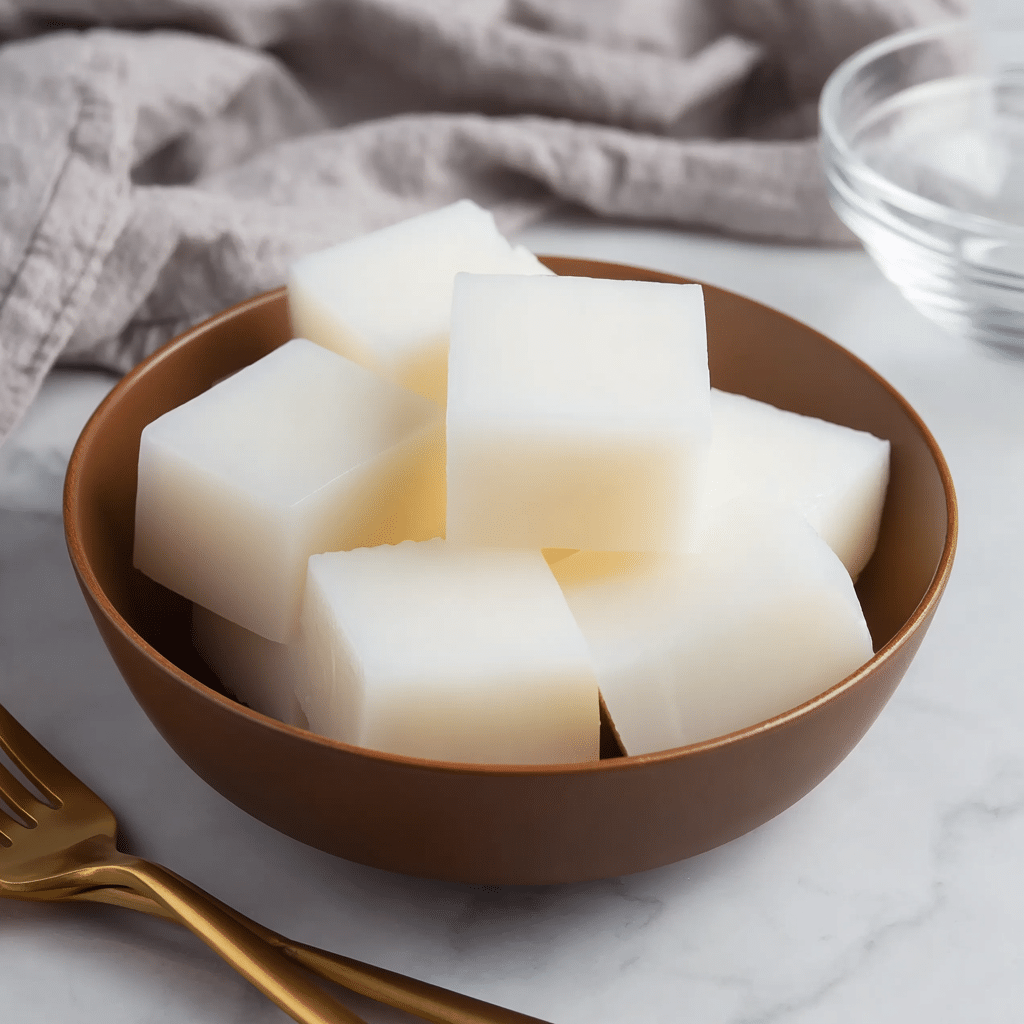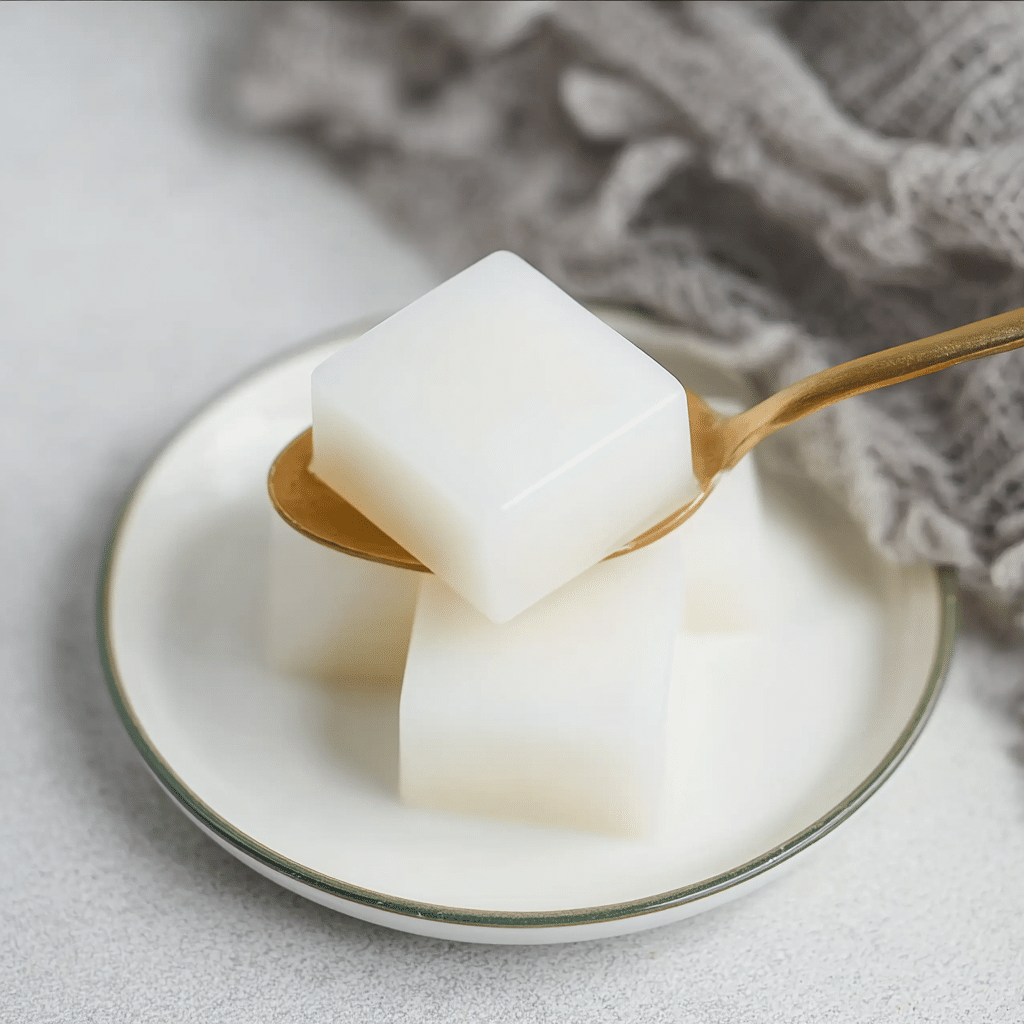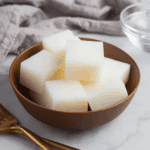Chinese coconut pudding Recipe
If you’ve ever dreamed of indulging in something silky, subtly sweet, and refreshingly tropical, then Chinese coconut pudding is exactly the treat you need to discover. This delicate dessert combines the creamy richness of coconut milk with the gentle firmness of gelatin, creating a luscious pudding that feels light but completely satisfying. Every spoonful transports you to a calm moment, where flavor and texture dance harmoniously—this pudding is truly a delightful way to enjoy coconut in a simple but elegant form.

Ingredients You’ll Need
One of the best parts about making Chinese coconut pudding is how few and straightforward the ingredients are. Each one plays a key role, from the creamy texture brought by coconut milk to the smooth setting power of gelatin, making this pudding a breeze to prepare while still tasting absolutely decadent.
- Coconut milk (400 ml): Use full-fat coconut milk for the richest, creamiest flavor; give the can a good shake to blend the coconut cream and water.
- Milk (300 ml): Any variety works, but whole milk adds a lovely creaminess that balances the coconut’s sweetness.
- Water (250 ml): Use cooled boiled or filtered water to dissolve the gelatin evenly without compromising flavor.
- White granulated sugar (135 g): Provides that perfect, subtle sweetness that harmonizes the coconut and milk.
- Gelatin (25 g): The essential setting agent that transforms the mixture into that satisfyingly wobbly, yet firm pudding.
How to Make Chinese coconut pudding
Step 1: Prepare Your Container
Start by lightly oiling the container you plan to set your pudding in. Using a few drops of oil and a brush to coat it evenly helps release the pudding smoothly once it sets, so you can enjoy perfect cubes or slices without any sticking or hassle.
Step 2: Mix Gelatin and Water
In a medium saucepan, combine the gelatin powder with the cooled water and stir well. Let it sit briefly to allow the gelatin to begin absorbing the water, which is crucial for achieving that ideal pudding texture.
Step 3: Add Milk to the Gelatin Mixture
Slowly pour in your milk while stirring the mixture gently to combine. This step ensures that the gelatin disperses evenly through the milk base, setting the stage for a smooth dessert.
Step 4: Incorporate the Coconut Milk
Before adding the coconut milk, give the can a vigorous shake to mix the coconut cream and liquid together. This simple step guarantees a consistent texture and avoids those unexpected lumps that can interrupt the silky texture of your Chinese coconut pudding.
Step 5: Stir in Coconut Milk and Sugar
Add the coconut milk to the saucepan and mix thoroughly. Next, sprinkle in the sugar while stirring to dissolve it evenly, melding the flavors together beautifully for a delicate sweetness that doesn’t overpower.
Step 6: Heat the Mixture Gently
Place the saucepan over low to medium-low heat, stirring constantly. The goal here is just to warm the mixture enough to fully dissolve the gelatin and sugar without boiling, preserving the smooth texture the pudding needs.
Step 7: Check for Dissolution
Test the mixture by scooping a bit with a spoon and looking for any gelatin bits. Once everything is completely dissolved with no specks left, remove the saucepan from heat to prevent overheating.
Step 8: Strain and Pour
Pour the pudding mixture through a sieve into your prepared container to catch any undissolved bits or bubbles. This little extra step guarantees a flawlessly smooth pudding every time.
Step 9: Remove Bubbles
If you want your Chinese coconut pudding to look professionally smooth, gently pop any visible bubbles with a spoon or toothpick. It’s a quick trick that creates a visually appealing surface, though it’s totally optional.
Step 10: Chill Until Set
Cover your container with a lid and refrigerate for at least 5 to 6 hours, ideally overnight. This patience pays off as the pudding firms up into the perfect gelatinous texture that makes this dessert so irresistible.
Step 11: Unmold and Slice
Once fully chilled, you can either slice the pudding directly in the container or gently unmold it by flipping it onto a cutting board. Give the edges a light press or a shake to release the pudding if it sticks, then cut it into cubes or your favorite shapes for serving.
How to Serve Chinese coconut pudding

Garnishes
To elevate the sweet creaminess of Chinese coconut pudding, try topping it with fresh tropical fruit like mangoes, lychees, or kiwi slices. A sprinkle of toasted coconut flakes or a few mint leaves can add a fresh, fragrant touch that complements the pudding’s gentle flavor beautifully.
Side Dishes
This pudding shines best as a light dessert following a flavorful meal. Pair it alongside stir-fried vegetables or a spicy main course to balance rich, bold flavors with its cool, creamy sweetness. It also pairs delightfully with jasmine tea for a soothing finish.
Creative Ways to Present
Transform your Chinese coconut pudding presentation by layering it with fruit purees or chia seed jelly in transparent glasses for a stunning visual effect. Or serve individual cubes skewered with fruit for an elegant party platter that’s sure to impress guests.
Make Ahead and Storage
Storing Leftovers
Chinese coconut pudding keeps wonderfully in the refrigerator for up to 3 days if covered properly. This makes it easy to prepare ahead and enjoy multiple servings without losing any softness or flavor.
Freezing
While freezing isn’t typically recommended due to changes in gelatin texture, if you must, freeze in airtight containers and thaw slowly in the fridge. Be aware freeze-thaw cycles may make the pudding less smooth and slightly watery.
Reheating
This pudding is best served cold, so reheating is generally not advised. If you prefer it slightly softer, let it sit at room temperature for 15 to 20 minutes before serving for a creamier mouthfeel.
FAQs
Can I use agar agar instead of gelatin?
Yes! Agar agar can be used as a vegetarian alternative, but keep in mind it sets firmer and faster, so you may need to adjust quantities and timing accordingly.
Is this pudding very sweet?
The sugar level is moderate, allowing the natural coconut flavor to shine. You can always adjust the sugar to your taste if you prefer it less sweet or a bit more indulgent.
Can I make this pudding vegan?
To make it vegan, substitute the milk with plant-based milk like almond or soy and replace gelatin with agar agar. The texture may vary slightly but will still be delicious.
What is the best way to unmold the pudding?
Lightly oiling the container before pouring in the mixture is key. When ready, gently press the sides and invert the container onto a plate or cutting board; a little gentle shaking often helps release the pudding smoothly.
How long does it take to set?
For the smoothest texture, chill the pudding for at least 5 to 6 hours, but overnight is even better to ensure it sets completely and develops that classic wobble.
Final Thoughts
Chinese coconut pudding is one of those comforting yet elegant desserts that’s surprisingly easy to master but always feels like a special indulgence. Whether you enjoy it plain or dressed up with fruits and garnishes, it promises a creamy, refreshing experience with every bite. Give it a try—you might just find yourself making it again and again!
PrintChinese coconut pudding Recipe
This Chinese coconut pudding is a silky, smooth dessert made with coconut milk, gelatin, and sugar. It offers a delicate balance of creamy coconut flavor and a light, jelly-like texture. Perfectly chilled, it is an ideal refreshing treat for warm days or as a unique dessert option for various occasions.
- Prep Time: 15 minutes
- Cook Time: 15 minutes
- Total Time: 6 hours 30 minutes (including chilling time)
- Yield: 6 servings 1x
- Category: Dessert
- Method: Stovetop, Refrigeration
- Cuisine: Chinese
- Diet: Halal
Ingredients
Liquid Ingredients
- 400 ml Coconut milk
- 300 ml Milk (any kind of cow’s milk: skim, 1%, 2%, or whole milk)
- 250 ml Water (cooled, boiled or filtered)
Dry Ingredients
- 135 g White granulated sugar
- 25 g Gelatin
Instructions
- Prepare the container: Lightly oil your container by adding a few drops of oil and brushing it evenly. This helps the pudding release easily once set. Set the container aside.
- Mix gelatin and water: In a medium saucepan, combine the gelatin and water. Stir well to begin dissolving the gelatin.
- Add milk: Pour the milk into the saucepan while stirring the mixture to combine thoroughly.
- Shake the coconut milk can: Before opening, shake the can well to mix any fat that has solidified at the top with the liquid, ensuring even consistency and easier pouring.
- Add coconut milk: Pour the well-mixed coconut milk into the saucepan while stirring.
- Add sugar: Incorporate the white granulated sugar into the mixture while stirring.
- Heat the mixture: Place the saucepan on low to medium-low heat, stirring constantly. Avoid bringing to a boil.
- Dissolve gelatin and sugar: Heat gently until all the sugar and gelatin have fully dissolved. Check by scooping some liquid onto a spoon to ensure no gelatin granules remain.
- Remove from heat: Once dissolved, turn off the stove and take the saucepan off the heat.
- Strain the mixture: Pour the mixture through a sieve into the prepared container to remove any lumps and ensure smoothness.
- Remove bubbles: Use a spoon to scoop out surface bubbles for a clean finish. Optional: use a toothpick to pop stubborn bubbles in corners.
- Chill: Cover the container with a lid and refrigerate for at least 5-6 hours, preferably overnight, until the pudding is set.
- Release pudding from container: Once chilled, either cut the pudding directly in the container for neater cuts or gently press around the sides to loosen and invert onto a cutting board.
- Slice and serve: Cut the pudding into cubes or your preferred shapes and enjoy.
Notes
- Use full-fat coconut milk for richer texture and flavor.
- Make sure your gelatin is fully dissolved to avoid lumps in the pudding.
- Do not boil the mixture to preserve smooth texture and prevent gelatin from breaking down.
- The pudding will keep well in the refrigerator for up to 3 days.
- Optional garnishes: top with fresh fruit or toasted coconut flakes for extra flavor.
Nutrition
- Serving Size: 1/6 of recipe (approx. 180 g)
- Calories: 220
- Sugar: 18 g
- Sodium: 40 mg
- Fat: 12 g
- Saturated Fat: 10 g
- Unsaturated Fat: 2 g
- Trans Fat: 0 g
- Carbohydrates: 25 g
- Fiber: 1 g
- Protein: 4 g
- Cholesterol: 10 mg
Keywords: Chinese coconut pudding, coconut jelly dessert, coconut gelatin pudding, Asian coconut dessert, gelatin pudding recipe








